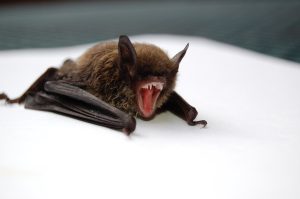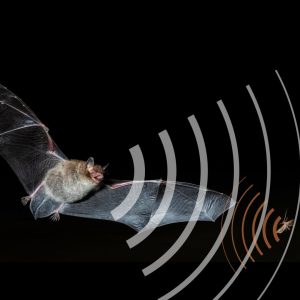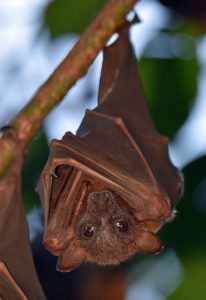Welcome back to this two-part blog series, where we are demystifying the remarkable world of bats! So far, we have covered the batty basics of the order Chiroptera, to which bats belong. If you have not yet read part one of this series, check it out here.
Florida’s Fabulous Flying Mammals
In Florida, we have 13 native species of bats. A few of the most common species in Sarasota County are:
- Mexican or Brazilian free-tailed bat (Tadarida brasiliensis)
- Tricolored bat (Perimyotis subflavus)
- Evening bat (Nycticeius humeralis)
- Seminole bat (Lasiurus seminolus)
- Northern yellow bat (Lasiurus intermedius).

Among these 13 species, most remain in Florida year-round. In addition to the 13 native species of bats found here, there are even some that occasionally find themselves a long way away from home here in the Sunshine State (Florida Bat Conservancy, 2020). These are what are called “accidental species”, and can come from both northern and southern locations (Florida Bat Conservancy, 2020). Learn more about the seven accidental bat species that may rarely be seen in Florida here.
All 13 bat species found in Florida are insectivorous- their diet consists entirely of insects, and they can eat around 1,000 in one night! This means good news for us humans- Florida’s bats are not interested in our blood, and they won’t turn into Dracula…whew! Their insectivorous eating habits also help control insect populations that can impact agriculturally significant crops. Despite the advantages to having bats around, these misunderstood animals are facing declining populations around the country and the world, due to the spread of devastating diseases such as White-Nose Syndrome, habitat loss, and the destruction of their roosts (Ober & Mazzotti, 2020). Learn more about bat conservation with this UF/IFAS Extension EDIS document.
Built-in Sonar!

Echolocation- maybe you’ve heard of it, but have you ever HEARD it? Chances are that you haven’t! Here’s why- out of the 13 native bat species in Florida, only one bat’s echolocation occurs at a frequency that is audible to humans! This bat is the Florida bonneted bat (Eumops floridanus), which can be found in habitats such as South Florida’s endangered and disappearing pine rocklands.
How does echolocation work, you might ask? When a bat sends out a sound wave as it flies, that sound wave bounces off nearby objects and insects, and returns to the bat as an echo, clueing it in to the location of prey items and potential obstacles in its flight path. Did you know that bats aren’t the only ones who use echolocation? A variety of other marine mammals also use echolocation to hunt.
And here’s where it gets interesting- humans can actually use echolocation as well! Daniel Kish, president and founder of World Access for the Blind, teaches workshops where children and adults with blindness can learn how to use a modified form of echolocation to navigate the world. Learn more about this important work here.
Coming Home After a Long Night
We know that bats are busy filling their bellies at night, but what do they do during the day? Bats generally roost, or settle in to rest, during the day individually, in groups, or in colonies, depending on the species. Floridian bats roost in palm fronds, clumps of Spanish moss in trees, inside of tree cavities, beneath bridges, in caves, and in man-made structures, such as buildings and bat houses. Fun fact- the University of Florida hosts up to 500,000 bats in the largest active bat houses in the world! These bat houses offer visitors the magical opportunity to watch as hundreds of thousands of bats pour out of their houses when the sun goes down. Learn how you can visit and view this sensational show here.
When the temperature drops, bats will enter a state called torpor, where they conserve energy for a few hours up to a month. Roosting in large colonies keeps bats in colder climates warm and comfortable in the winter. It also provides safety and security for communal breeding efforts. If you are wondering how you can help provide safe habitat for bats, try installing bat houses on your property or within your community. Bats won’t be satisfied with just any old house- they look for roosts that are high off of the ground, and prefer houses of a certain height and width, with specific interior temperatures and space for landing as they enter the house (Ober, 2020). Find some tips and recommendations for installing bat houses that will be more attractive and beneficial for bats here.

Rogue Roosters
One question remains- what do you do if a bat comes to visit you? It is illegal to kill or harm a bat here in Florida, and we’ve got some helpful tips and tricks for you to safely and kindly show your visitor the door. Bats generally enter the home for two different reasons. One reason is by accident! While flying and hunting for insects in the night, a bat may find its way through an open window or door in pursuit of a juicy treat! Common human activities, like leaving lights on at night, can attract concentrations of insects that may bring bats into the area. If a bat enters your home by accident, remain calm and start by isolating the bat in one room by closing all doors leading to other rooms in the home. Turn indoor lights off and open all windows to the outside in that room.
The second reason that bats may be found in your home could be due to a colony of bats roosting within it. After confirming that you are indeed operating a bat hotel, you’ll want to learn how to get your batty residents to move on. Identify where the bats are coming in, and apply bat exclusion devices to those entry points, which will allow bats to exit the roost at night, but will prevent them from coming back in. Before you close up shop, it is important to remember that it is illegal to exclude bats during maternity season, which is around April 15th-August 15th. During this time, mother bats will leave their babies in the roost to go out in search for food. If they cannot get back into the roost, those babies will die from starvation.
It is important to remember never to handle bats. If you see a bat on the ground, do not attempt to pick it up.
Batty for Bats?

I hope that this blog series has helped to shine a little bit of light on the darkness within which the world of bats takes place. Full of knowledge and leading with understanding, we can move through our world with fascination rather than fear- learning how to better coexist with our wild friends along the way.
Want to learn more about bats? Visit our wildlife webpage for more information and a free Wild Sarasota webinar all about bats. Missed part one of this series? Don’t worry, you can find it here.
Resources
Florida Bat Conservancy. (2020). Accidental Bat Species in Florida. https://www.floridabats.org/accidental-species.html
Ober, H. K. (2020). Effective Bat Houses for Florida. EDIS. Retrieved October 31, 2023, from https://edis.ifas.ufl.edu/publication/UW290
Ober, H. K. & Mazzotti, F. J. (2020). Conservation of Bats in Florida. EDIS. Retrieved October 31, 2023, from https://edis.ifas.ufl.edu/publication/UW291
 1
1
